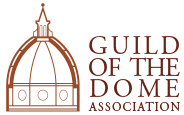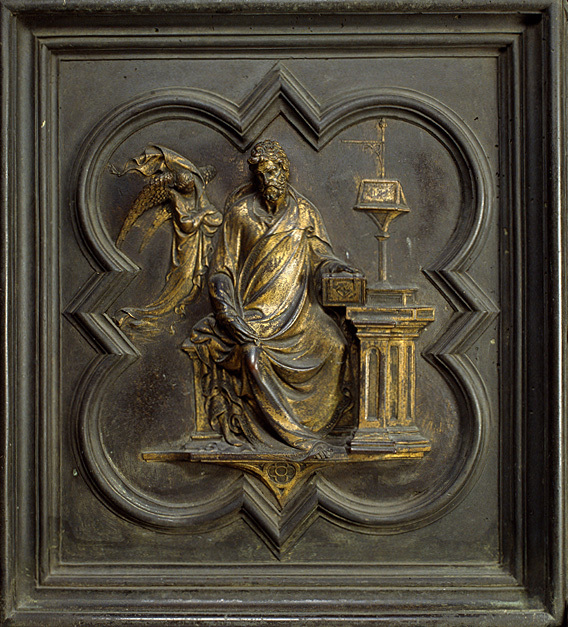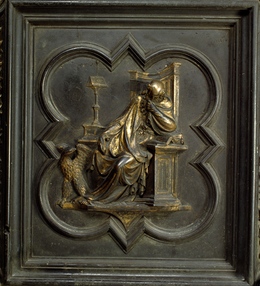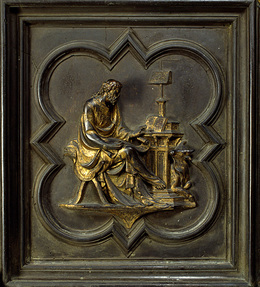Panel XXII - Matthew
Panel details:
“for I was hungry and you gave me food; I was thirsty and you gave me drink; I was a stranger and you took me in; I was naked and you clothed me; I was sick and you visited me; I was in prison and you came to me ”. Matthew 25:35-45
The apostle and evangelist Matthew, whose name means “gift of god”, was born near the end of the first century b.C. in Capernaum, a town on the north western shore of Lake Tiberias. He was the son of Alpheus and was given the name Levi. Many historians assume that he changed his name, as was the custom then, indicating the change in his life. He was a tax collector, which in that era was called publican. He practiced his profession in the city of Capernaum, under the reign of tetrarch Herod Antipas and was a member of one of the categories the Jews despised the most as tax agents collected taxes from those who had contracts with the Roman government. Tax collectors paid all taxes in advance and then became moneylenders, deceiving and cheating the same people from whom they had collected taxes. His job was to recover the investments of his employers. The high priests, in obeisance of the first commandment, forbade the Jewish people to handle Roman coins bearing the image of the emperor and consequently publicans were deemed sinners because they worshiped the emperor. Matthew was called directly by Christ to become one of the twelve apostles. Jesus had observed him while he was at his collecting bench outside, and shortly after he had healed a paralytic, he called him. Matthew stood up abruptly, leaving everything behind him and followed Christ. From that moment on, tax collecting ceased to exist for him. The episode of Matthew’s calling is recorded in the gospels: “then he went out, and caught sight of a publican, called Levi, sitting at work in the customs house, and said to him, “follow me!” Luke 5:27; “and as he passed further on, he saw Levi, the son of Alphaeus, sitting at work in the customs-house, and said to him, follow me; and he rose up and followed him”. Mark 2:14.
We know very little about Matthew’s life. His name is mentioned together with the other apostles in acts (1:13), immediately after the ascension of Jesus into heaven. Further in acts, it is narrated that Matthew was present at the election of Matthias, who took the place of Judas Iscariot. He was standing with the other eleven apostles when Peter, on the day of pentecost, spoke to the crowd, announcing that Jesus is the “Lord and Christ.” It is certain that he preached in Palestine, to his countrymen, but there are no references of any further ministry there. It has been reported that Matthew preached in numerous territories, such as Syria, Macedonia and Ireland, though ancient tradition more consistently reports that he preached in Ethiopia (that is, in Colchis on the Euxine) and the testimony of St Clement of Alexandria verified he practiced meditation and led a most austere life, eating only herbs, roots and wild fruits. Traditionally, Roman martyrology as well confirms Matthew died a martyr there and commemorates him on 21 september. The martyrology of St JeRome indicates the martyrdom of Matthew on the same day in Persia, in the city of Tarrium, which is elsewhere indicated as being located in Ethiopia, so that there appears to be no contradiction between the sources. There are several conflicting versions, instead, regarding the death of Matthew. According to the versions reported by Clement of Alexandria and the gnostic Heracleon, Matthew would have died of natural causes. Additional versions have reported that he died in the city, today the Georgian city of Gonio, where he would be buried in the ancient Roman fortress. This version, though, refers more likely to the burial of the apostle Matthias. According to the tradition of the Church, Matthew would have died in Ethiopia. Some of the apocryphal passiones, authenticated in the Legenda Aurea (late thirteenth century) by Jacopo da Varagine, affirm that Matthew converted king Egippo and the entire territory he ruled, Ethiopia, to Christianity, after he miraculously resurrected his daughter Iphigenia. Tradition further recounts that at the death of the king, his brother, Hyrtacus, who succeeded him to the throne, desired to marry the daughter of the deceased king, Iphigenia, even though she had consecrated her virginity to Jesus Christ. The young girl rejected his marriage proposal, whereby Hyrtacus requested Matthew to persuade her to give herself to him. The saint responded to the king, inviting him to listen to his sermon the following saturday at the temple in the presence of the entire population. That Saturday, the apostle solemnly proclaimed that Iphigenia’s vow of marriage with the heavenly king could not be broken to marry an earthly king, because, he elucidated, if a servant usurped the wife of his king, the servant would surely and rightly be burned alive.
According to tradition, st Matthew was killed at the altar while he was in the act of celebrating mass, pierced by the sword of an assassin whom the king had sent. The date of Matthew’s death is unknown as is the occasion in which his body was transported to the west. A legend places this event around the year 370, when sailors would have presumably removed his remains from the Ethiopian coasts at velia. The monk Athanasius discovered the body of the saint near the hot springs of the ancient Phocean city, Elea (later called Velia by the Romans; today in the municipality of Ascea, province of Salerno), home of the philosopher Parmenides. When the Saracens conquered the city in 412, the saint’s remains were removed and hidden from the monk Athanasius, in Lucania, near the present day church of st Matthew in Casal Velino, in a place called Ad Duo Flumina. His remains were transferred again after a brief stop in Rutino, near Capaccio (third deposition), the episcopal see that took the place of the ancient, abandoned Paestum. Roman martyrology commemorates the arrival of the body of Matthew in Salerno on 6 May as the Lombard king Gisulfo I (946-977) would have brought him there on that day in the year 954. This tradition is referenced in the Chronicon Salernitanum, composed by an anonymous scribe in the monastery of San Benedetto in Salerno in 978 as well as in two other concurring medieval texts. There had been no news of the whereabouts of the relics for more than a century, when they were discovered again in Salerno in 1080 and placed in the crypt of the cathedral consecrated by pope Gregory VII, where they are still today. The letter the pope wrote to the archbishop of salerno, Alfano, on 18 September of that year, in which he mentioned finding the relics, historically confirms the date 1080. There were also minor relics of Matthew located in Rome. One of these, in a silver shrine (now empty) that the future pope Victor III brought to Rome in 1050 as a gift to Cencio Frangipane, had been found in May 1924 during an inspection, in the pit under the altar of the crypt in the church of Saints Cosmas and Damian. It is believed that part of an arm of Matthew is located in Santa Maria Maggiore, which pope Paul V (1605- 1621) probably brought as a gift.
In addition to the canonical gospel, apocryphal texts traditionally attributed to Matthew are the gospel of pseudo Matthew, which recounts the childhood of Jesus, the acts of Matthew and the martyrdom of Matthew, both of which describe his ministry.
There are many legends and stories about the miracles and the events of the saint’s life primarily in the apocryphal writings that are quite fascinating, though they are not substantiated. Matthew was portrayed as a miracle worker, through divine intervention, which he performed mainly during his “mission” in Ethiopia.
The canonical gospel of Matthew, one of the three synoptic gospels, was not written in Greek, but in “Hebrew” or the “father” language, according to ancient authors. It was probably written in Aramaic, the language then spoken in Palestine. an ancient text by Papias, bishop of Hierapolis in Asia minor (110 or 120 ad) referred by the Christian historian Eusebius (263-339 ad), indicates: “Matthew composed the words”. While not everyone agrees on this tradition, it must be mentioned because it asserts that Matthew actually wrote the first gospel in Aramaic. Some scholars maintain that Mark may have procured many ideas from it to write his own gospel and that Matthew’s would have been translated into Greek at a later date, after the gospel of Mark, thereby determining that Matthew’s gospel would actually be the second one. The priest origen, according to Eusebius, reported that the first gospel was addressed to the believers of judaism and is considered the “Palestinian gospel” par excellence. Matthew was evidently more interested in communicating first to the Christians of Jewish origin because it was vital to present the teachings of Jesus to them for the approval and fulfilment of mosaic law. When Matthew’s gospel was later translated into Greek, it was addressed to everyone. The Church uses Matthew’s gospel everywhere as an instrument for preaching, during liturgy. The gospel is composed of seven parts. The first part is an introduction to the genealogy of Christ while the conclusive part is the explanation of all the other parts. The main objective of the evangelist is the kingdom of heaven, which he illustrates in five aspects, as if to symbolize the five books of the pentateuch, written, or at least inspired, by Moses. Hence, Matthew presents Jesus as the new moses who revealed the new commandment to his disciples: love. Not surprisingly, the first of the five great dissertations, beatitudes, is proclaimed on the mountain, just as moses proclaimed his speech to the nascent community of Israel from mount Sinai, handing them the Torah, the law of the ten commandments that
He had received directly from god. it is interesting to observe that Matthew’s text was addressing the Jewish community based on the fact that in the gospel of Matthew the genealogy of the messiah stops at Abraham, the forefather of the Jewish people, while the gospel of Luke continues to Adam, the first man, thereby giving the message of Christianity a universal dimension, extending beyond the borders of Israel.
The iconography of Matthew predominantly depicts him as elderly and bearded. His symbol is an angel that inspires and guides his hand while he is writing his gospel. There is also a sword, symbol of his martyrdom, near him. his symbol is in fact a winged man or angel demonstrating the humanity of Jesus. Similarly to the other evangelists, four mysterious animals described by the prophet Ezekiel, and the revelation of st John also represent st Matthew. the fathers of the church acknowledge the almost manlike animal figure of the revelation depicting st Matthew, who begins his gospel with the event of the birth of Jesus. St Matthew is the patron saint of the city of Salerno as well as protector of tax collectors, accountants, bankers and bookkeepers.
The first representations of st Matthew are found in the gospels and in the illuminated manuscripts, where he is almost always depicted surrounded by his symbols, intent on writing.
Over the centuries artists of all genres have depicted the saint virtually in the same manner.
Lorenzo Ghiberti created the panel depicting st Matthew on the North Door of the Baptistery in Florence between 1403-15. The panel belongs to the first phase of his work, which still reflects the influence of late gothic style. His adherence to gothic-international influence is evidenced in the accented decorations of the figures, the draperies and in the rhythm of the composition that describes the scene. Ghiberti conformed to the international gothic style, while at the same time he introduced spatial perspective innovations of the early Renaissance style. The other panels created in the early stages of the work, together with the evangelists include agony in the garden, Jesus among the doctors, temptation of Christ, transfiguration, crucifixion, the last supper, the figures of the fathers of the church.
Ghiberti positioned the figure depicting the saint in the centre and completely inscribed in the quatrefoil frame while the figure and lectern on his left are represented in prospective with clear reference to church furnishings of the period. St Matthew is sitting down and has been depicted in old age with a beard and short hair; the figure is static and seen from the front, his head slightly tilted to the right, with an attentive expression, listening intently to the fully depicted angel, on his right. The angel is moulded clearly in gothic style; it is in a curved position, lending dynamism to the figure and the elegant drapery moving in the wind. The saint’s right hand is resting on his leg and his left hand is on the closed book on the lectern to the left. His body is enveloped in the large tunic that covers it entirely, while from the folds of the drapery, a foot timidly emerges. The entire composition denotes a balance of shapes and movements, allowing the viewer to perceive the scene of Matthew intensely still and attentive, listening to the words from the angel sent by the divine wind.
During the time Ghiberti was working on the bronze reliefs on the North Door of the Baptistery, he also sculpted a bronze statue of st Matthew commissioned to him by the merchant’s guild which sought to rival the wool guild that had commissioned the sculpture of st John the evangelist, now located in the Orsanmichele church and museum in Florence.



